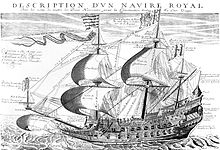Georges Fournier (Jesuit)

Georges Fournier (31 August 1595 – 13 April 1652) was a French Jesuit priest, geographer and mathematician.
Biography
Fournier served as a naval military chaplain on a ship of the line,[1] and acquired a strong knowledge of technical and naval matters.
In 1642, he published the treaty Hydrographie, where he attempted to provide a scientific foundation to the design of ships.[2][3] At the time, results like Couronne or HMS Sovereign of the Seas were obtained by empirical trials and errors.
He also authored a Treaty of fortifications or military architecture, drawn from the most estimated places of our times, for fortifications,[4] whose original edition was published in Paris in 1649 by Jean Hénault at the Salle Dauphine of l'ange gardien. Another edition was published in 1668 in Mayence by Louis Bourgeat.[5]
Georges Fournier taught René Descartes.
Works

In 1642, Fournier published his Commentaires géographiques.[6] The following year he published in Paris the work which will give him the essential part of his celebrity: the Hydrographie contenant la théorie et la pratique de toutes les parties de la navigation.[7] Resolutely scientific,[3] it is the first French maritime encyclopedia.[8] Dedicated to Louis XIII, it was reprinted many times (1667, 1679, 1973). Geographer, astronomer, hydrographer, mathematician, Fournier took an interest in everything: winds and tides, ports, fishing, maritime trade, shipbuilding, the conduct of officers and the art of command.[8] The Hydrographie was therefore a first-rate source for the history of the navy during the first half of the seventeenth century, which explains the "magnificent re-edition" of this work in 1973 (Etienne Taillemite).[6] Georges Fournier also published in 1643 a Traité de la sphere[8] and in 1644 a Traité de géométrie.[6] His Traité des fortifications ou Architecture militaire (published in Paris in 1649 [9]) was translated into Dutch, Spanish and German.[4] His works on Euclidean geometry (Paris, 1644 and 1654) were translated into English, and gave rise to three successive editions.[8] In 1656, posthumously appeared his Asiae nova descriptio (New Description of Asia).[8] The book was made in collaboration with several jesuit missionaries.[8]
See also
Notes and references
- ^ Notice d'autorité de la Bibliothèque nationale de France.
- ^ Acessible en ligne sur le site European Cultural Heritage Online
- ^ a b Bertrand Gille, Histoire des techniques.
- ^ a b Voir bibliographie et traité en ligne sur le site Architectura du Centre d'études supérieures de la Renaissance à Tours.
- ^ Bibliothèque municipale de Mayence, collection Rara III i 30 ba.
- ^ a b c Taillemite 2002, p. 194.
- ^ Accessible en ligne sur le site European Cultural Heritage Online
- ^ a b c d e f Michel Vergé-Franceschi, dans Vergé-Franceschi 2002, p. 624.
- ^ La deuxième édition est accessible en ligne.
Bibliography
- Fournier, Georges (1643). Hydrographie, contenant la théorie et la practique de toutes les parties de la navigation... Paris: Soly. BNF 304555507
- Gille, Bertrand (1978). Histoire des techniques. Paris: Gallimard. ISBN 978-2-07-010881-7.
- Taillemite, Étienne (2002). Dictionnaire des Marins français. Tallandier. ISBN 2-84734-008-4.
- Vergé-Franceschi, Michel (2002). Dictionnaire d'Histoire maritime. Paris: Robert Laffont. ISBN 2-221-08751-8.
